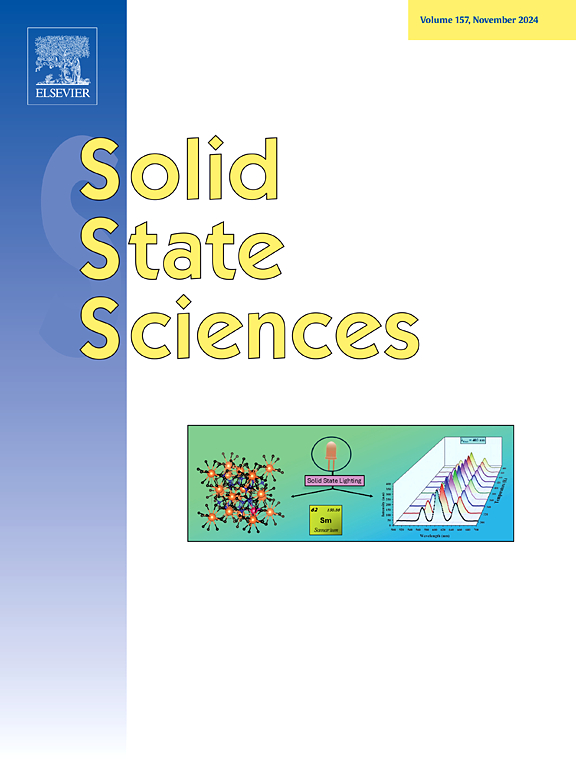Na1+2xMxZr2-x(PO4)3 (M - Mg, Mn) nasicon型陶瓷材料的合成及离子电导率
IF 3.4
3区 化学
Q2 CHEMISTRY, INORGANIC & NUCLEAR
引用次数: 0
摘要
采用共沉淀法合成了Na1+2xMxZr2-x(PO4)3 (M−Mg, Mn)陶瓷。利用x射线衍射、Rietveld细化、扫描电镜和阻抗谱对样品进行了表征。所研究的磷酸盐属于NASICON型结构。结果表明,在所研究的体系中形成了固溶体(0≤x≤1.0)。为了研究化学成分和烧结添加剂对电导率的影响,分别制备了含氧化锌和不含氧化锌(2 wt%)添加剂的两种磷酸盐陶瓷。所研究的磷酸盐的离子电导率遵循Arrhenius定律,并随着x的增长而达到最大值。结果表明,氧化锌的加入也导致了晶格中锆的部分取代和离子电导率的提高。添加2 wt% ZnO的Na2.6Mg0.8Zr1.2(PO4)3陶瓷的电导率最高(6.8∙10−3 S cm−1,673 К)。本文章由计算机程序翻译,如有差异,请以英文原文为准。

Synthesis and ionic conductivity of Na1+2xMxZr2-x(PO4)3 (M – Mg, Mn) NASICON-type ceramic materials
Ceramics of the Na1+2xMxZr2-x(PO4)3 (M − Mg, Mn) composition were synthesized by the co-precipitation technique with subsequent annealing. The samples were characterized using X-ray diffraction with the Rietveld refinement, scanning electron microscopy, and impedance spectroscopy. The studied phosphates belong to the NASICON type structure. The solid solutions (0 ≤ x ≤ 1.0) were shown to be formed in the investigated systems. To study the effect of the chemical composition and sintering additive on conductivity, two series of ceramics were prepared for each phosphate: with and without ZnO (2 wt%) additive. The ionic conductivity of the studied phosphates followed the Arrhenius law and passed through a maximum with x growth. It was shown that the addition of zinc oxide also leads to partial substitution of zirconium in the lattice and an increase in ionic conductivity. The highest conductivity was achieved for the Na2.6Mg0.8Zr1.2(PO4)3 ceramic with 2 wt% ZnO additive (6.8∙10−3 S cm−1 at 673 К).
求助全文
通过发布文献求助,成功后即可免费获取论文全文。
去求助
来源期刊

Solid State Sciences
化学-无机化学与核化学
CiteScore
6.60
自引率
2.90%
发文量
214
审稿时长
27 days
期刊介绍:
Solid State Sciences is the journal for researchers from the broad solid state chemistry and physics community. It publishes key articles on all aspects of solid state synthesis, structure-property relationships, theory and functionalities, in relation with experiments.
Key topics for stand-alone papers and special issues:
-Novel ways of synthesis, inorganic functional materials, including porous and glassy materials, hybrid organic-inorganic compounds and nanomaterials
-Physical properties, emphasizing but not limited to the electrical, magnetical and optical features
-Materials related to information technology and energy and environmental sciences.
The journal publishes feature articles from experts in the field upon invitation.
Solid State Sciences - your gateway to energy-related materials.
 求助内容:
求助内容: 应助结果提醒方式:
应助结果提醒方式:


